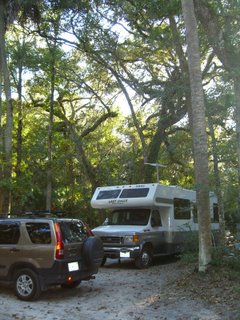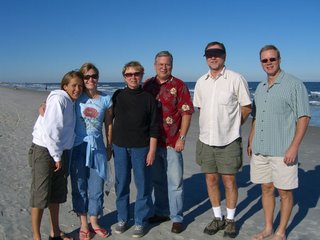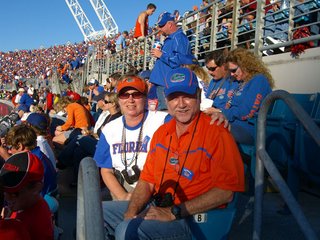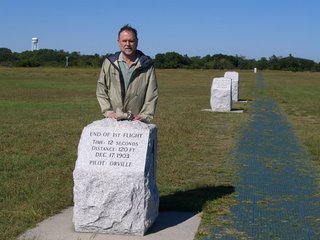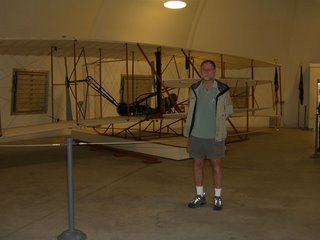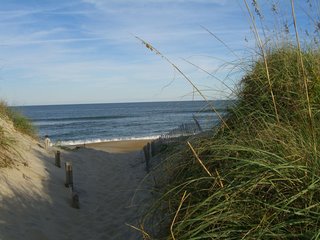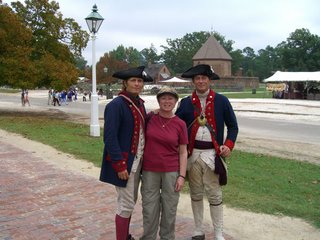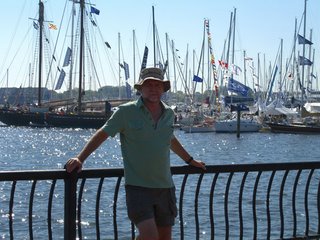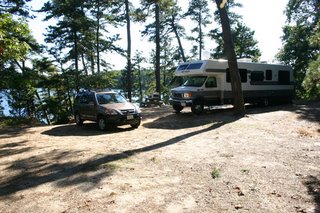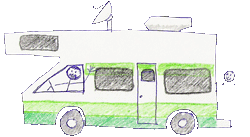
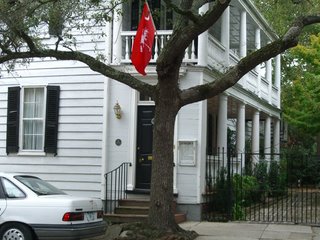
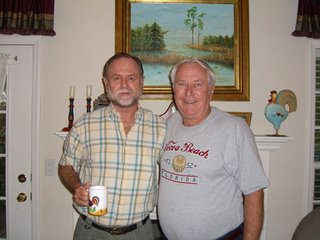
We arrived at Huntington Beach State Park (no surfers here), just south of Myrtle Beach, S.C. on Wed., Oct 18. We had to cross over a freshwater lagoon to reach the camping area on the beach. Much to our surprise we could see four or five alligators sunning themselves on a raised area a few feet from our road. We noticed a sign saying “Do not feed the alligators”. The camping brochure warned campers to be aware of alligators and snakes, particularly at night. (For sure, this is not the southern California Huntington Bch). It was a surprise to us that the campground was almost full. The retirees and snow birds are here.
The area around the campground had many trails running through the marsh areas with viewing sites for wildlife and in particular birds. There were many exotic birds just walking through the campground. The beach was a short walk from our campsite. Loggerhead sea turtles lay their eggs here and the nests are marked with stakes and yellow police tape. It is against the law to disturb these nests.
We would have liked to have stayed here another day but we wanted to allow enough time for thoroughly visiting Charleston, SC and Savannah, Georgia. So we moved on to Charleston, S.C. a full 80 miles to the south.
We spent one night in our RV outside Charleston and then drove inland to visit and stay with a cousin of John’s. John grew up with his cousin Bob in Cocoa, Florida and they spend many hours reminiscing about childhood experiences and the good ole days when they ran track together in high school. Many of the stories are not repeatable.
After much visiting, eating and a good night’s sleep we were off and driving back to Charleston on Sat. Oct. 21.
Charleston is a lovely 300 year old city located on a peninsula between the Ashley and Cooper rivers. We took a tour of the historic area with its many pre Revolutionary War and 1700 and 1800 era homes. The picture will show some unusual characteristics of these homes. The houses were taxed according to the front footage on the street. The houses are built very narrow with the front porch, front door and gardens facing to the side of the house. There is a small door on the street that appears to go into the house but really enters the front porch on the side of the house. The slope of the porch floor is steep (so that rain can drain off) and the doors are cut accordingly.
There are many restored plantations located outside the city that can be toured. Also, Ft. Sumter (of Civil War fame) is located at the mouth of the Charleston harbor.
We ate at Jestine’s (thanks Debbie K for the recommendation) and had a typical southern meal of fried chicken, green beans, mashed red potatoes and shrimp and grits.
We tried to walk off our big lunch with a stroll through the city market area just a few blocks away. There were a dozen large open air buildings with stalls where people sold local crafts. The most unique crafts were the hand woven grass baskets made by African American women. We are told that it is becoming a lost art.
Our next destination was Savannah, Georgia, 120 miles to the south. Savannah has been called “the most beautiful city in North America”. We readily agree. We took a tour of the city to get ourselves oriented and then went back to walk the streets to observe the period homes and lovely parks. It is very easy to walk the historical area because it only covered about one square mile and is set out in an easy to follow grid pattern. The homes are arranged around 24 beautifully landscaped squares (parks) with 200 year old oak trees. This was the town plan that was designed by Gen. James Oglethorpe. He arrived in 1733 and it was the 13th British colony.
There is a cobblestone river walk with shops, restaurants and a view of ships going up the Savannah River. ( The cobblestones were ballast in English cargo sailing ships) There are many restaurants in the city but the longest lines were for The Lady and Sons, Paula Dean’s restaurant.
